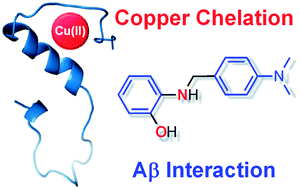A small molecule that displays marked reactivity toward copper– versus zinc–amyloid-β implicated in Alzheimer's disease†
Abstract
Alzheimer's disease (AD) is a complex, multifactorial, neurodegenerative disease that poses tremendous difficulties in pinpointing its precise etiology. A toolkit, which specifically targets and modulates suggested key players, may elucidate their roles in disease onset and progression. We report high-resolution insights on the activity of a small molecule (L2-NO) which exhibits reactivity toward Cu(II)–amyloid-β (Aβ) over Zn(II)–Aβ.

- This article is part of the themed collection: 2014 Emerging Investigators

 Please wait while we load your content...
Please wait while we load your content...